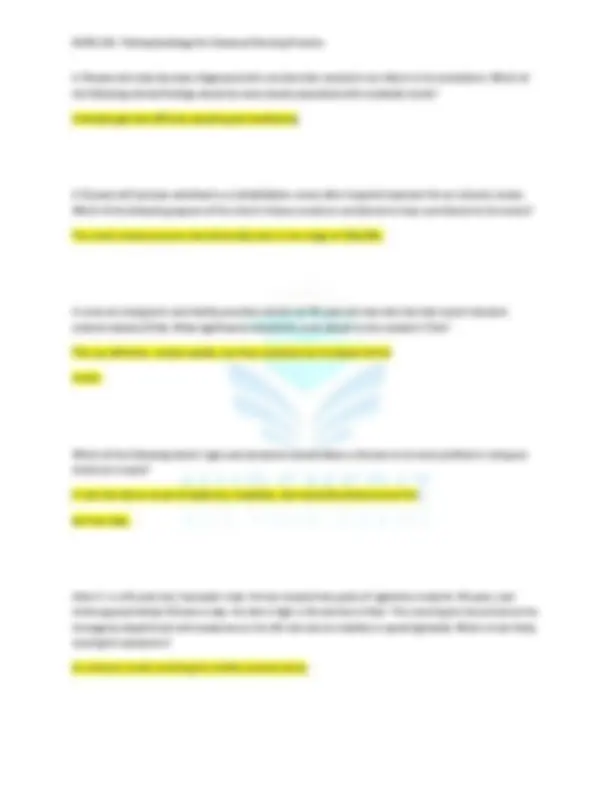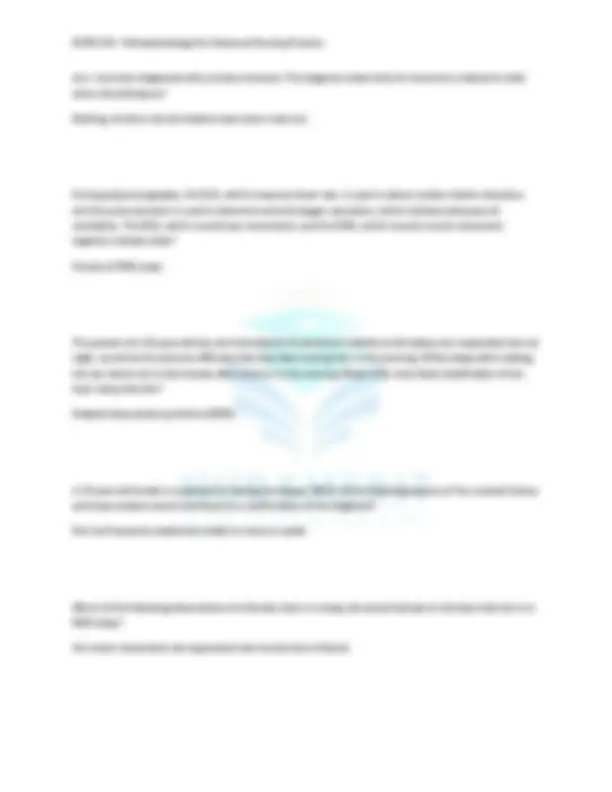











Study with the several resources on Docsity

Earn points by helping other students or get them with a premium plan


Prepare for your exams
Study with the several resources on Docsity

Earn points to download
Earn points by helping other students or get them with a premium plan
Community
Ask the community for help and clear up your study doubts
Discover the best universities in your country according to Docsity users
Free resources
Download our free guides on studying techniques, anxiety management strategies, and thesis advice from Docsity tutors
NURS 618 FINAL EXAM 1 2025 Pathophysiology for Advanced Nursing Practice A+ GRADED |COMPLETE McNeese State University
Typology: Exams
1 / 15

This page cannot be seen from the preview
Don't miss anything!










A 48 year-old male has a new diagnosis of Guillain-Barre syndrome. Which of the following processes underlies the deficits that accompany the degeneration of myelin in his peripheral nervous system (PNS)? Nerve cells lack insulation and impulse conduction is compromised by the destruction of myelin. A badly burned firefighter has been in an induced coma for three weeks. When he awakens, he thanks his son for singing to him a week earlier. Which part of the brain is responsible for allowing him to hear and comprehend while comatose? Thalamus a 20-year-old female who has been in a coma since her accident has now had her condition declared a persistent vegetative state. How can her care providers most accurately explain an aspect of her situation to her parents? "Though she still goes through a cycle of sleeping and waking, her condition is unlikely to change." A nurse on a neurology unit is assessing a female client with a brain-injury. The client is unresponsive to speech, and her pupils are dilated and do not react to light. She is breathing regularly, but her respiratory rate is 45 breaths per minute. In response to a noxious stimulus, her arms and legs extend rigidly. What is her level of impairment? Coma A male newborn infant has been diagnosed with spina bifida occulta. Which of the following pathophysiological processes has most likely contributed to the infant's health problem?
The vertebral arches around his neural tube have failed to completely close. During a clinical assessment of a 68 year-old client who has suffered a head injury, a neurologist suspects that a client has a sustained damage to her vagus (CN X). Which of the following assessment findings is most likely to lead the physician to this conclusion? The client has difficulty swallowing and has had recent constipation and hypoactive bowel sounds. Following a spinal cord injury suffered in a motor vehicle accident, a 22 year-old male has lost fine motor function of his finger and thumb, but is still able to perform gross motor movements of his hand and arm. Which of the following components of his white matter has most likely been damaged? The outer layer (neolayer) Several months ago, a 20-year-old male suffered a spinal cord injury brought about by a snowboard trick gone wrong. The lasting effects of his injury include flaccid bowel and bladder and the inability to obtain an erection. While sensation has been completely preserved in his legs and feet, his motor function is significantly impaired. What type of incomplete spinal cord injury has the man most likely experienced? Conus medullaris syndrome A nurse educator is explaining basic neuroanatomy to a class of prospective nursing students. Which of the following statements best conveys an aspect of the role of cerebrospinal fluid (CSF)? CSF cushions the brain and provides a near-water medium for diffusion of nutrients.
A 60-year-old male client with a long history of back pain has had little success with a variety of analgesic regimens that his family physician has prescribed. He has recently been diagnosed formally with a chronic pain disorder. Which of the following teaching points about chronic pain would his physician most likely emphasize to the client? "These pain signals your body is sending likely serve no real, useful, or protective function." A nurse on a post-surgical unit is providing care for a 76-year-old female client who is 2 days post- hemiarthroplasty (hip replacement) and who states that her pain has been out of control for the last several hours, though she is not exhibiting signs of pain. Which of the following guidelines should the nurse use to guide short-term and longer-term treatment of the client's pain? Knowing that the client's self-report of pain is the most reliable indicator of pain. Which of the following hospital patients is most likely to be diagnosed with complex regional pain syndrome II (CRPS II)? A man who has been admitted for treatment of continuing hyperalgesia after sustaining a nerve injury in a motor vehicle accident. A clinician is providing care for an 84-year-old female resident of a long-term care facility with numerous health problems including osteoporosis, congestive heart failure, venous leg ulcers, and vascular dementia. Staff at the care facility note that the woman has been frequently complaining of back pain in recent weeks and intermittently groans. Which of the following factors is likely to complicate the clinician's assessment and treatment of the client's pain? Assessment and treatment are possibly complicated by the large number of drugs that the client receives.
A 60-year-old male office worker has presented to a clinic due to his recent lower back pain. Which of the following components of his assessment and history would be most indicative or a serious pathological process? His onset of pain has been gradual and he has no prior history of lower back problems. A female client with bone metastases secondary to lung cancer is admitted for palliative radiation treatment and pain control. The client is presently experiencing pain that she rates at 9 out of 10. Which of the following non-pharmacological treatments is most likely to be a useful and appropriate supplement to pharmacological analgesia at this point? Relaxation and distraction A nurse practitioner is assessing a 7-year-old boy who has been brought to the clinic by his mother, who is concerned about her son's increasingly frequent, severe headaches. Which of the nurse's following questions is least likely to yield data that will allow for a confirmation or ruling out of migraines as the cause of his problem? "Does your son have any food allergies that have been identified?" A client on an acute medicine unit of a hospital with a diagnosis of small bowel obstruction is complaining of intense, diffuse pain in her abdomen. Which of the following physiological phenomena is most likely contributing to her complaint? Nociceptive afferents are conducting the sensation of pain along the cranial and spinal nerve pathways of the ANS.
A 72 year-old patient has just begun to experience an ischemic stroke. The blood supply from the middle cerebral artery is being blocked by a large blood clot. How long before brain cells begin to die due to lack of ATP? 4 - 6 minutes A 51-year-old has been diagnosed with an astrocytic brain tumor. Which of the following statements by the oncologist treating the client is most accurate? "Unfortunately, surgery for the treatment of brain tumors rarely cures the problem." Following a collision while mountain biking, the diagnostic work up of a 22-year-old male has indicated the presence of an acute subdural hematoma. Which of the following pathophysiological processes most likely underlies his diagnosis? Blood has accumulated between the man's dura and subarachnoid space. A patient has experienced severe head trauma. She is unresponsive to visual stimuli, and when she is removed from the respirator there is no visible effort to breathe. What is the best diagnosis given these factors? Brain death Which of the following individuals would be most likely to experience global ischemia to his or her brain? A man who has entered cardiogenic shock following a severe myocardial infarction.
A 70-year-old male has been diagnosed with a stroke that resulted in an infarct to his cerebellum. Which of the following clinical findings would be most closely associated with cerebellar insult? Unsteady gait and difficulty speaking and swallowing A 51-year-old has been admitted to a rehabilitation center after hospital treatment for an ischemic stroke. Which of the following aspects of the client's history would be considered to have contributed to his stroke? The client's blood pressure has historically been in the range of 150s/90s. A nurse at a long-term care facility provides care for an 85-year-old man who has had recent transient ischemic attacks (TIAs). What significance should the nurse attach to the resident's TIAs? TIAs, by definition, resolve rapidly, but they constitute an increased risk for stroke. Which of the following clients' signs and symptoms would allow a clinician to be most justified in ruling out stroke as a cause? A man has had an onset of weakness, headache, and visual disturbances over the last two days. Allen H. is a 62-year-old, Caucasian male. He has smoked two packs of cigarettes a day for 30 years, and drinks approximately 10 beers a day. His diet is high in fat and low in fiber. This morning he has arrived at the emergency department with weakness on his left side and an inability to speak (aphasia). What is most likely causing his symptoms? An ischemic stroke involving the middle cerebral artery
Joe J. has been diagnosed with primary insomnia. This diagnosis states that his insomnia is related to what other clinical feature? Nothing, all other clinical relations have been ruled out During polysomnography, the ECG, which measures heart rate, is used to detect cardiac rhythm disorders, and the pulse oximeter is used to determine arterial oxygen saturation, which indicates adequacy of ventilation. The EOG, which records eye movements, and the EMG, which records muscle movement, together indicate what? Periods of REM sleep The parents of a 15-year-old boy are frustrated at his persistent inability to fall asleep at a reasonable hour at night, as well as the extreme difficulty that they have rousing him in the morning. While sleepy after waking, the son claims not to feel drowsy after lunch or in the evening. What is the most likely classification of the boy's sleep disorder? Delayed sleep phase syndrome (DSPS). A 17-year-old female is suspected of having narcolepsy. Which of the following aspects of her medical history and sleep analysis would contribute to a confirmation of the diagnosis? She has frequently awakened unable to move or speak. Which of the following observations of a female client in a sleep lab would indicate to clinicians that she is in REM sleep? Her motor movements are suppressed and muscle tone is flaccid.
Which of the following findings during sleep observations of clients in a sleep lab would be most likely to be considered pathologic? A woman spends the majority of her sleeping hours in REM sleep. Which of the following individuals would be expected to have the highest risk of developing sleep apnea? A man with poorly controlled diabetes and hypertension. A physician is explaining to an intern the varieties of sleep disorders and the relative risk of each disorder. Which of the following motor disorders of sleep can be life threatening? Obstructive apnea A 60-year-old male complains to his physician that he is always tired. No matter how much he sleeps, he does not feel rested. His wife also states that he is a terrible snorer, and she is not getting any sleep either. The physician suspects sleep apnea. How can he confirm his diagnosis? Polysomnography A patient is complaining of back pain. In his history you see that his father had ankylosing spondylitis. Which of the following pathophysiological phenomena would be most indicative of ankylosing spondylitis? Loss of motion in the spinal column and eventual kyphosis A 16-year-old boy has been diagnosed with ankylosing spondylitis. Which of the following etiologies is responsible for his health problem? Immune response
A 68-year-old woman has had her mobility and quality of life severely affected by rheumatoid arthritis (RA). Which of the following pathophysiological events involved in her health problem occurred first? T-cell mediated immune response Following a progressive onset of fatigue, aching and joint stiffness over the last two years, a 69-year-old male has recently been diagnosed with rheumatoid arthritis (RA). Which of the following teaching points should his primary care physician include during the office visit in which this diagnosis is communicated to the client? "Steroids and anti-inflammatory drugs that I'll prescribe will likely bring some relief to your symptoms." Jane T. has rheumatoid arthritis. From time to time, she experiences intense joint pain. Which of the following issues should her care team also be on the lookout? Anorexia Though the client's primary care provider has downplayed the symptoms, a geriatrician suspects that an 82- year-old female has polymyalgia rheumatica. Which characteristic symptomatology would most likely have led the specialist to suspect this health problem? The woman complains of aching and morning stiffness in her neck, shoulder, and pelvis. Which of the following individuals is most likely to develop a form of reactive arthritis? A 24 - year-old male who completed treatment for a chlamydial infection one year ago.
After falling off his bicycle, an 8-year-old boy has a large abrasion on his posterior thigh that has removed the epidermis in the region, but left the dermis largely intact. Which of the following changes in integumentary system would be expected in the area of his wound? Fewer Merkel and Langerhans cells in the region A 40-year-old male client has a congenital syndrome that affects the function of the Langerhans cells of his epidermis. The man's care provider would expect which of the following manifestations of his condition? Increased susceptibility to infection Clinical investigation of a 40-year-old female client with diverse dermatological signs and symptoms has focused on the woman's basement membrane. Which of the following skin functions would a clinician most likely attribute to a region of the integument other than the basement membrane? Lack of sensory nerve impulse conduction Which of the following statements best conveys an aspect of the process of keratinization? The stratum germinativum continuously produces new keratinocytes to replace losses. A man's primary care physician has characterized his skin lesion as being a temporary eruption, but has cautioned him against repeated rubbing or scratching as to avoid lichenization. What is the most likely categorization of the man's skin lesion? A rash